
A
custom manure management set-up—including the Biolynk system by
Daritech—is more than exceeding the promised solids capture rate on the
Volbeda Dairy farm, and is allowing the farm to effectively deal with
solids build-up in its lagoons.
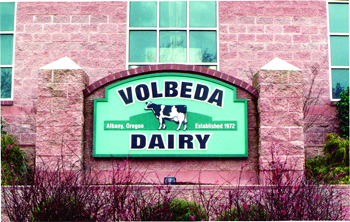
|
A custom manure management set-up—including the Biolynk system by Daritech—is more than exceeding the promised solids capture rate on the Volbeda Dairy farm, and is allowing the farm to effectively deal with solids build-up in its lagoons.
In 1972 John Volbeda, his wife Lucy Ann and their two sons moved from California to take over an existing 400-acre dairy farm in Albany, Oregon.
Over the next three decades, the Volbedas grew the dairy into a substantial operation. They milk 1,800 cows, raise dry stock on a separate 300-acre piece and employ 40 people. John’s son Rob has a Holstein/Jersey dairy near West Salem, Oregon—Volbeda Farms—where he is producing award-winning cheese under the name “Willamette Valley Cheese Company” and brother Darren manages Volbeda Dairy with his father.
The only things remaining from the original Volbeda Dairy are the house and half a barn. A newer, higher-tech dairy has expanded around it, including a new parlor, a flush barn that houses approximately 1,000 cows, as well as a year-old Daritech Biolynk manure system.
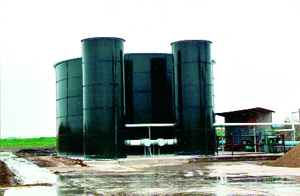 The processing tank and thickening tanks on the Volbeda Dairy. The processing tank and thickening tanks on the Volbeda Dairy. |
As years went by and the farm expanded, John built four lagoons to handle the manure capacity—92 acre feet in total. “We stopped separating about 15 years ago,” says Darren. “At that point my dad’s theory was that we’d just pump it into the lagoon and then pump it out every year.”
The solids slowly built up. “We grow corn, but can’t pump the thick solids on the crop and we have a limited time period to get solids out,” explains Darren. “It had reduced our lagoon capacity. It was time to do something.”
John and Darren started looking for a new system. And Mike Gamroth, extension dairy specialist at Oregon State University, worked with them to help find a solution. “We discussed the options,” says Gamroth. “There are various ways to clean a lagoon. John looked at a more traditional liquid solid separator, but there is substantial cost associated with all of them and he started looking at new technology.”
“We had tried side hill separators, but they didn’t work well for us,” says Darren. “We were continually scrubbing them out. I wanted to try to find something that was less maintenance and that I didn’t have to worry about.”
At the Oregon Dairy Convention in 2003, John and Darren learned about the Biolynk system by Daritech, which the company said could capture between 50 and 70 percent of their solids. John wanted that guarantee in writing. Daritech owner Dave DeWaard said the company was open to that, and a guaranteed 55 percent capture rate was written into the contract.
“I was skeptical,” says Gamroth. “But I told John if the company was willing to put that in writing, what did he have to lose.”
The Biolynk system was constructed and began operation in February 2005. Like all Daritech systems, it was customer-tailored to the farm. The flush dairy already had three collection pits (one for each barn), which they had been pumping directly into the lagoons. Taking that into account, the Biolynk system began with the construction of a main reception pit, 45 feet across and 12 feet deep, for all pits to be pumped into.
At first sight the system looks complex, but it was designed with simplicity in mind, both in infrastructure and operation. It has basically a four-stage process. First, at the main reception pit, a 40 horsepower Houle Agri-pump agitates the contents and at the same time feeds it up to an Accent IFRS 36 separator, set 26 feet in the air. The larger solids are separated through a 3/16-inch screen.
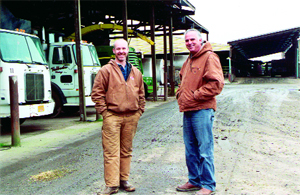 Darren Volbeda (left) and Daritech’s Steve Peerce at the Volbeda Dairy in Albany, Oregon. The dairy has already seen a number of benefits from its new manure management system, including a constant, clean supply of fresh water, says Darren. Darren Volbeda (left) and Daritech’s Steve Peerce at the Volbeda Dairy in Albany, Oregon. The dairy has already seen a number of benefits from its new manure management system, including a constant, clean supply of fresh water, says Darren. |
“To maximize the performance of this separator we over-feed it a little bit. What the separator doesn’t take out goes back into the pit to go through again,” explains Steve Peerce, a representative for Daritech.
Next the liquid coming off the separator is gravity fed into a 26-foot, 220,000-gallon processing tank at the tank’s base. As the liquid flows in at the bottom, the clean water at the top is gravity fed back into the barns for flush water.
The processing tank is the most important part of the system, and it’s crucial that solids have time to settle, resulting in minimal suspended solids at the top. “The balance of manure, water and timing that goes on inside this tank is critical,” explains Peerce. “The size and shape of this tank are based on a number of criteria. And timers control when it happens. Someone couldn’t just build one of these without understanding the balances required. It would take a lot of trial and error.”
The solids at the bottom of the processing tank are gravity fed into two,
26-foot tall alternating thickening tanks—stage three. The alternating thickening tanks allow time for one tank to be completely still and settle while the other empties. When one empties, the top liquid decants to the lagoons and the slurry from the bottom flows into a 5,000-gallon concrete pit.
At the pit, a Houle pump takes the contents to the last stage—a Fan PS1 780 screw press, which sits 16 feet in the air. More solids are captured there, through a .35 mm screen.
The Biolynk system not only captured the guaranteed 55 percent, but based on the last tests is capturing at a 62 percent rate. Peerce says the company is as pleased with the results as the Volbedas. “This sort of system is ideal for a flush dairy because it relies on dilution. Even though the Volbedas only flush about 75 percent and scrape the rest, it hasn’t been a problem. And the dairy isn’t using any more water than they normally do.”
Darren has already seen a number of benefits. One is a constant, clean supply of flush water. “We were flushing with a pump from the lagoon. We always had to pump our lagoons as low as we can go, and for two months out of the year we had no flush at all because I had to drain my lagoons.”
The new system also eliminated issues with Nutria, an invasive rodent that chewed through power cords and hoses out to the lagoons.
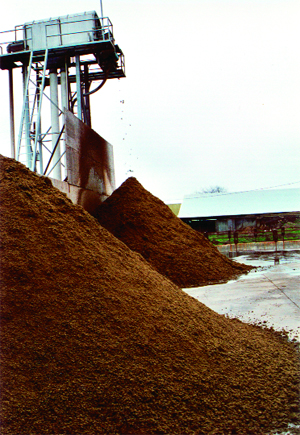 A big shock for everyone was the amount of solids coming off the separators—approximately 100,000 pounds a day. The dairy’s management plans to start composting the material, creating a saleable product. A big shock for everyone was the amount of solids coming off the separators—approximately 100,000 pounds a day. The dairy’s management plans to start composting the material, creating a saleable product. |
The big shock for everyone was the amount of solids coming off the separators—approximately 100,000 pounds a day from 2,200 cows (equivalent to 20,000+ pounds dry material). “Just to think that we were putting that into our lagoon every day, it sort of wakes you up,” says Darren. “No wonder we’re in the condition we are.”
With all those solids, Darren is quickly learning the science behind composting. “We just started composting this fall,” he says.
“We’re using it as bedding. We’ve mixed it with paper/pulp —a byproduct of the paper mill that we use. It’s worked out real well. Next year we’re going to do a lot more and hopefully supply bedding year round.”
But bedding is only the start. Already looking to compost on a large scale, the Volbedas put in a cement slab 100 feet by 300 feet next to the tanks when the Biolynk system went in.
They plan to build a roof over it this spring and that’s where Darren intends to start seriously composting and creating a salable product. “With the volume of compost we’re going to produce, I need to find some pretty big markets. I’m already talking to people who are interested.”
To assist with the composting, the Volbedas did their research and bought a Brown Bear paddle aerator. “I went with it because I can get more compost in a smaller area. For my situation, once we have a roof up, I want to have as much under that roof as possible,” says Darren.
Darren has the Brown Bear paddle aerator on a Ford Versatile 9030. “You can drive it forward to backward, so it works great. You just need a really slow gear. When you’re doing a big, wet pile, you’re just creeping through that thing.”
The Volbedas are also working at getting their lagoons back in good shape—two in particular have a substantial amount of solids. Darren expects it will take three to four years. “We’ve been working the last couple years with our neighbor—a grass seed farmer. We agitate aggressively and try to get as many solids in what goes onto his field because he can use the organic matter.
The first year we did it he got his highest yield ever.”
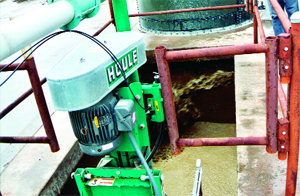 At the 5,000-gallon concrete pit, a Houle pump take the solids from the thickening tanks up to the Fan PS1 780 screw press. At the 5,000-gallon concrete pit, a Houle pump take the solids from the thickening tanks up to the Fan PS1 780 screw press. |
The Volbedas would like the lagoons in good shape because they are looking to expand in the near future—adding two more barns and milking close to 3,000. “With the Biolynk system and the lagoons completely empty, I would never have to worry about capacity. I can get up to 3,000 cows and not worry about it.”
Darren says he would recommend Biolynk to anyone who wanted to remove solids. “I have more than I know what to do with,” he says with a smile. “But now I’m dealing with solid instead of the liquid form. That gives me the opportunity to get it off the place, where the liquid never did. And that’s my goal—what I don’t use as bedding, I want to get off my place.”
Steve Peerce emphasizes that even if another farm did purchase this system, it wouldn’t necessarily look the same: “For example, besides managing flush water and solids, it can be adapted to feed a digester—offering the dairyman the ability to manage the dairy the way he chooses. Volbeda’s is definitely a custom system.”